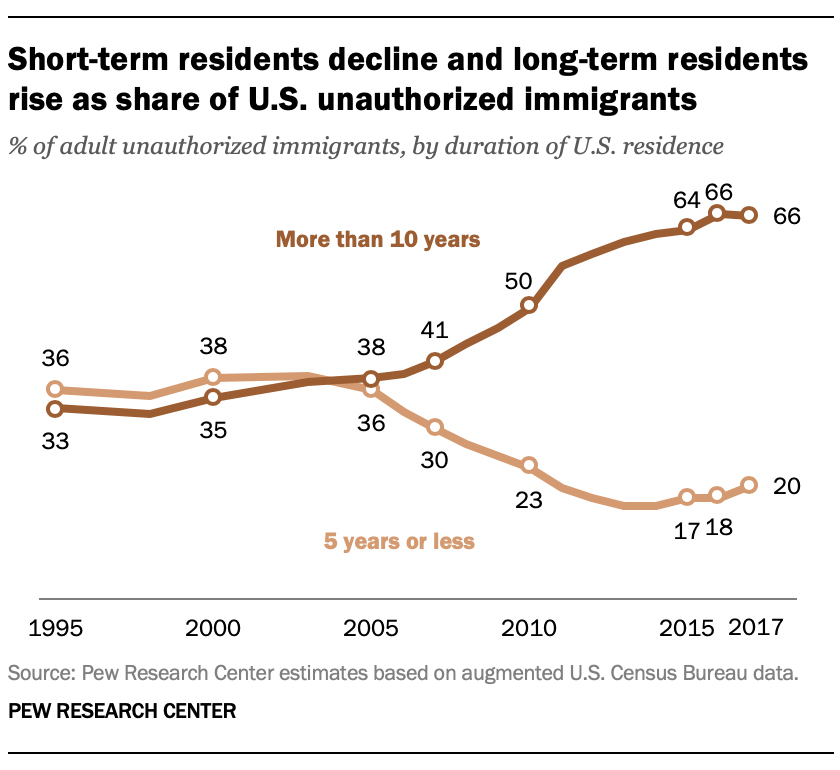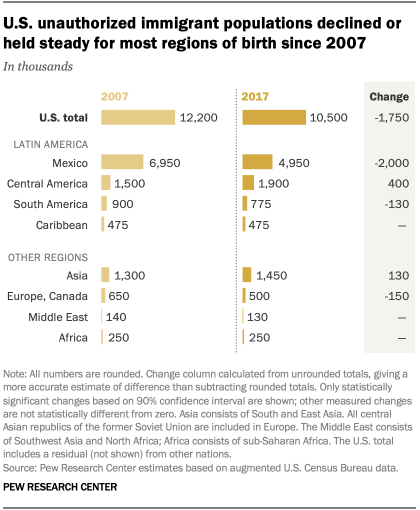Border Patrol apprehensions of migrants at the U.S.-Mexico border are on the rise again. Although the majority of people attempting to enter the United States illegally are stopped, this trend could foreshadow an increase in the U.S. unauthorized immigrant population after years of relative stability. Yet the activity at the southwestern U.S. border is only one part of the overall story of unauthorized immigration, as a growing share of this population came from regions other than Mexico or Central America and entered the U.S. legally but overstayed their visas.
The unauthorized immigrant population is always changing and churning. The total number in the country can remain stable or decline even as new immigrants enter illegally or overstay a visa, because some voluntarily leave the country, are deported, die or become lawful residents. In short, the dynamic nature and pace of migration patterns has resulted in an unauthorized immigrant population whose size and composition has ebbed and flowed significantly over the past 30 years.
The U.S. unauthorized immigrant population rose rapidly from 1990 to 2007 before declining sharply for two years and stabilizing at 10.5 million in 2017. Pew Research Center’s most recent estimate is well below a peak of 12.2 million in 2007, but roughly triple the estimated 3.5 million in 1990. The estimate includes 1.5 million or more people who have temporary permission to stay in the U.S. through programs such as Deferred Action for Childhood Arrivals (DACA) and Temporary Protected Status (TPS), as well as people awaiting decisions on their asylum applications; most could be subject to deportation if government policy changed.
Mexican unauthorized immigrants are no longer the majority of those living illegally in the U.S. As of 2017, 4.9 million unauthorized immigrants in the U.S. were born in Mexico, while 5.5 million were from other countries, the first time since at least 1990 that those from Mexico (47% in 2017) were not a majority of the total. In 2007, an estimated 6.9 million unauthorized immigrants were Mexican, and 5.3 million were born in other countries. The population of Mexican-born unauthorized immigrants declined after 2007 because the number of newly arrived unauthorized immigrants from Mexico fell dramatically – and as a result, more left the U.S. than arrived.
The number of unauthorized immigrants from nations other than Mexico ticked up between 2007 and 2017, from 5.3 million to 5.5 million. The population of unauthorized immigrants born in Central America and Asia increased during this time, while birth regions of South America and Europe saw declines. There was not a statistically significant change among other large regions, including the Caribbean, Middle East-North Africa and sub-Saharan Africa.
A rising share of U.S. unauthorized immigrants apparently arrived in the country legally but overstayed their visas. Nearly all people apprehended while attempting to enter the country illegally at the U.S.-Mexico border are from either Mexico or Central America. This stands in contrast to the origins of visa overstays.
In recent years, immigrants from countries outside of Mexico and Central America accounted for almost 90% of overstays, and in 2017, there were more than 30 overstays for every border apprehension for these countries. Although the Census Bureau data Pew Research Center uses to estimate the size of the unauthorized immigrant population does not indicate directly whether someone arrived with legal status, the origin countries of immigrants in these sources provide indirect evidence. From 2007 to 2017, the share of newly arrived unauthorized immigrants (those in the U.S. five years or less) from regions other than Central America and Mexico – the vast majority of whom are overstays – increased from 37% to 63%. At the same time, the share of new unauthorized immigrants from Mexico fell from 52% to 20%.

The decline in the arrival of new unauthorized immigrants in recent years has resulted in a population that is increasingly settled in the U.S. About two-thirds of unauthorized immigrants (66%) had lived in the U.S. for more than 10 years as of 2017, up from 41% 10 years earlier. Conversely, newly arrived unauthorized immigrants (those in the U.S. five years or less) accounted for 20% of the unauthorized immigrant population in 2017 versus 30% in 2007. For Mexicans, the pattern is even more pronounced. The vast majority (83%) of unauthorized immigrants from Mexico have been in the country more than 10 years, while only 8% have lived in the U.S. for five years or less.






No responses yet